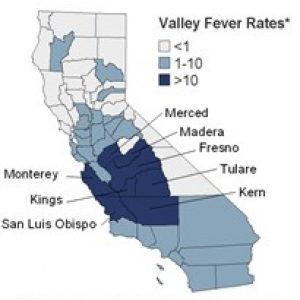What is Valley Fever?
Valley Fever is caused by a microscopic fungus known as Coccidioides immitis which lives in the top two to 12 inches of soil in many parts of the state. When soil is disturbed by activities such as digging, driving, or high winds, fungal spores can become airborne and potentially be inhaled by workers. Populations with more than 20 cases annually of Valley Fever per 100,000 people are considered highly endemic.
While the fungal spores are more likely to be present in the soils of the Central Valley, they may also be present in other areas of California. The map below shows the areas with the greatest incidence of reported human Valley Fever cases.
- Fresno
- Kern
- Kings
- Madera
- Merced
- San Luis Obispo
- Tulare

map source: CDPH Valley Fever Fact Sheet
How can Valley Fever be Prevented?
While there is no vaccine to prevent Valley Fever, the following steps are important to take in order to limit risk:
- Determine if your worksite is in an endemic area.
- Adopt site plans and work practices that reduce workers’ exposure, which may include:
- Minimize the area of soil disturbed.
- Use water, appropriate soil stabilizers, and/or re-vegetation to reduce airborne dust
- Stabilize all spoils piles by tarping or other methods.
- Provide air conditioned cabs for vehicles that generate heavy dust and make sure workers keep windows and vents closed.
- Suspend work during heavy winds.
- Onsite sleeping quarters, if provided, should be placed away from sources of dust.
- When exposure to dust is unavoidable, provide NIOSH-approved respiratory protection with particulate filters rated as N95, N99, N100, P100, or HEPA. Employers must develop and implement a respiratory protection program in accordance with Cal/OSHA’s Respiratory Protection standard (8 CCR 5144).
- Take measures to reduce transporting spores offsite, such as:
- Clean tools, equipment, and vehicles before transporting offsite.
- If workers’ clothing is likely to be heavily contaminated with dust, provide coveralls and change rooms, and showers where possible.
- Identify a health care provider for occupational injuries and illnesses who is knowledgeable about the diagnosis and treatment of Valley Fever
- Train workers and supervisors about the risk of Valley Fever, the work activities that may increase the risk, and the measures used onsite to reduce exposure. Also train on how to recognize Valley Fever symptoms.
- Encourage workers to report Valley Fever symptoms promptly to a supervisor. Not associating these symptoms with workplace exposures can lead to a delay in appropriate diagnosis and treatment.
What work activities increase the risk of Valley Fever?
When fungal spores are present, any work activity that disturbs the soil, such as digging, grading or other earth moving operations, or vehicle operation on dirt roads, can cause the spores to become airborne, therefore increasing the risk of Valley Fever. All workers on sites where the fungus is present, and who are exposed to dusty conditions and wind-blown dusts are at increased risk of becoming infected.
- Construction workers and other workers on construction sites, including road building and excavation crews
- Archeologists
- Geologists
- Wildland firefighters
- Military personnel
- Workers in mining, quarrying, gas and oil extraction jobs
- Agricultural workers*
* Cultivated, irrigated soil may be less likely to contain the fungus
compared to undisturbed soils.
What should employers do if a worker reports Valley Fever symptoms?
- Report all hospitalized cases and deaths to Cal/OSHA.
- Complete the “Employer’s Report of Occupational Injury or Illness” (Form 5020) for each suspected occupational Valley Fever illness.
- Send the worker to a workers’ compensation healthcare provider or occupational medicine clinic whose staff is knowledgeable about Valley Fever. Alert the provider or clinic to the possibility that the employee was exposed to dusts that may contain coccidioides spores. Physicians must submit a “Doctor’s First Report of Occupational Injury or Illness” (Form 5021) for each employee evaluated for occupational Valley Fever.
- Record all cases on the Cal/OSHA Log 300.
ASHLEY BARAJAS
